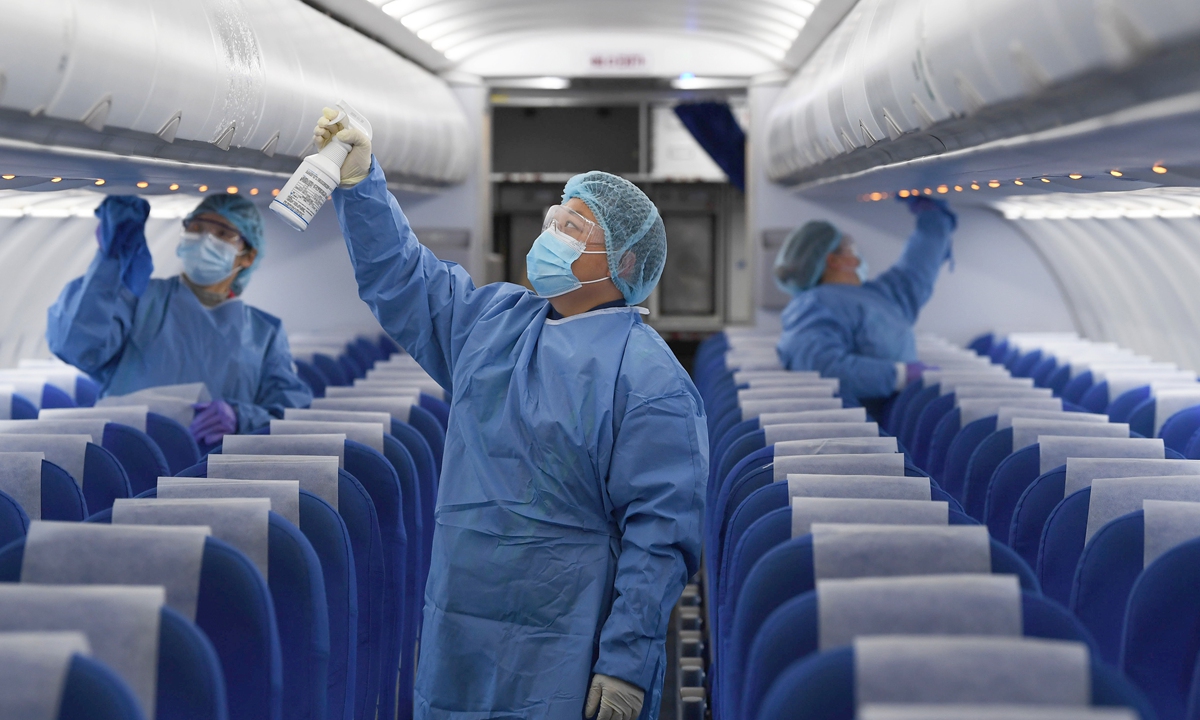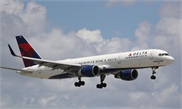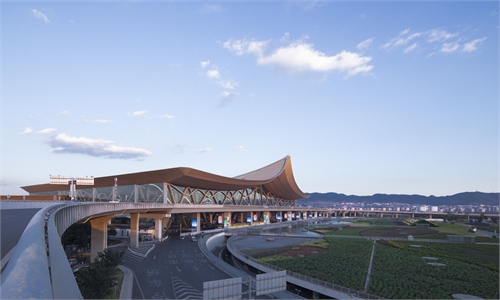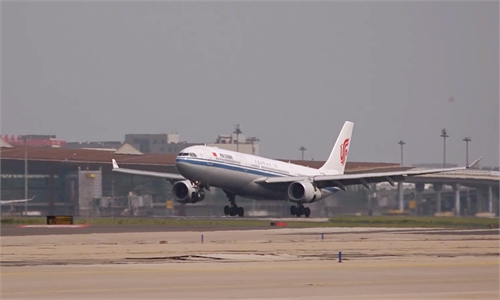
Ground service staff spray disinfectant through an aircraft cabin at Hefei Xinqiao International Airport, East China's Anhui Province on January 23, 2021. Photo:VCG
China is about to enter the 40-day Spring Festival travel rush from next week. To meet demand, China's aviation regulator said on Wednesday that it has approved an additional 20,000 flights as of January 10.The regulator also said it will encourage airlines to transfer idle capacity and slots for overseas flights to domestic routes and provide more flexibly to meet the needs of the travelling public.
However, what is usually a seasonal bump for airlines is being hampered by a flare-up of COVID-19 cases across the country, and while there has been a slight rise in flights, the recent performance of the aviation sector remains well below pre-pandemic levels.
Annual target
Officials from the Civil Aviation Administration of China (CAAC) said at the agency's annual work meeting on Monday that the industry is working to turn around a negative trend and help airlines return to profit, noting that a landscape with minimal COVID-19 was a key pre-condition for a sustained recovery.
In a detailed briefing, civil aviation officials set a target of completing a total transportation turnover of 104 billion ton-kilometers, 570 million passenger trips, 7.8 million tons of cargo with the goal of recovering to around 85 percent of pre-epidemic levels during 2022.
In comparison, in 2021, China's civil aviation completed a total of 85.7 billion ton-kilometers of transportation, up 7.3 percentage points than the previous year, recovering to 66.3 percent of 2019 levels, the most recent virus free year on record.
In terms of passenger and cargo traffic, the number hit 440 million passenger trips and 7.32 million tons, an increase of 5.5 and 8.2 percentage points year-on-year, respectively, recovering to 66.8 percent and 97.2 percent of 2019 levels.
The data reflects that the actual performance of civil aviation in 2021 was far from meeting expectations, given that at the beginning of 2021, the CAAC predicted that the passenger traffic volume in 2021 could recover to 90 percent of pre-epidemic levels.
Airlines have been forced to think of creative ways to survive, with major carriers facing a third consecutive year in the red.
As a means to boost revenue, in addition to continuing to cut costs, many domestic airlines have also begun to try and make money outside of air tickets by developing more auxiliary products.
For example, Juneyao Airlines and Sichuan Airlines have done market testing around offering upgraded in-flight meals. While keeping basic meals included as part of each airfare, economy class passengers can choose to spend an extra 30-50 yuan ($4.7-7.9) to upgrade to a premium menu package.
In addition to streamlining domestic operations, airline fortunes also hang on whether high levels of vaccination will lead to the restoration of profitable international routes in 2022.
The CAAC said on Monday that it will closely track the global epidemic situation and changes in the international air transport market, and implement policies, prudently and dynamically to control the resumption of international passenger flights.
The CAAC also confirmed that the government has rolled out several new measures to relieve pressure on the struggling sector, cutting nearly 20 billion yuan in cost for the industry.
The regulator said it had encouraged airlines to reduce costs, improve efficiency, and adjust their strategies according to market conditions, forming their own differentiated competitive advantages.
Painful 2021
Looking back, 2021 was the second year in which the civil aviation industry faced unprecedented challenges.
The ongoing epidemic and new variants caused China's civil aviation, which had begun to recover, to again suffer from an artificially restricted market.
The third quarter of last year, the traditional peak season for civil aviation, was again marred by recorded losses amongst domestic airlines.
Ten domestic airlines, including unlisted airlines such as Xiamen Airlines and Shenzhen Airlines, lost a total of 11.997 billion yuan in the third quarter of last year, with only budget carrier Spring Airlines managing to make a profit, according to yicai.com.
In the first three quarters of 2021, 10 domestic airlines lost a total of 31.5 billion yuan.
The epidemic and new viral strains also led market expectations for the fourth quarter of 2021 to be well below that of 2020, with many experts predicting that airlines face further bleeding in 2022.



